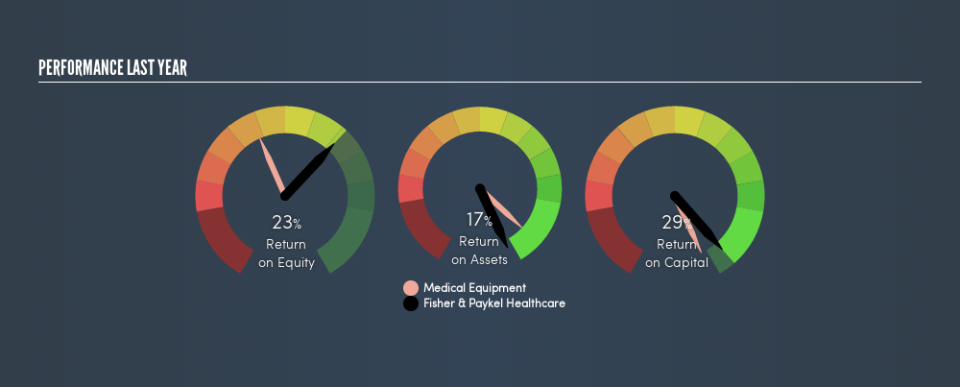Are Fisher & Paykel Healthcare Corporation Limited’s (NZSE:FPH) High Returns Really That Great?

Today we'll look at Fisher & Paykel Healthcare Corporation Limited (NZSE:FPH) and reflect on its potential as an investment. To be precise, we'll consider its Return On Capital Employed (ROCE), as that will inform our view of the quality of the business.
First of all, we'll work out how to calculate ROCE. Then we'll compare its ROCE to similar companies. Finally, we'll look at how its current liabilities affect its ROCE.
Return On Capital Employed (ROCE): What is it?
ROCE measures the 'return' (pre-tax profit) a company generates from capital employed in its business. In general, businesses with a higher ROCE are usually better quality. In brief, it is a useful tool, but it is not without drawbacks. Author Edwin Whiting says to be careful when comparing the ROCE of different businesses, since 'No two businesses are exactly alike.'
How Do You Calculate Return On Capital Employed?
The formula for calculating the return on capital employed is:
Return on Capital Employed = Earnings Before Interest and Tax (EBIT) ÷ (Total Assets - Current Liabilities)
Or for Fisher & Paykel Healthcare:
0.29 = NZ$293m ÷ (NZ$1.2b - NZ$184m) (Based on the trailing twelve months to March 2019.)
Therefore, Fisher & Paykel Healthcare has an ROCE of 29%.
See our latest analysis for Fisher & Paykel Healthcare
Is Fisher & Paykel Healthcare's ROCE Good?
One way to assess ROCE is to compare similar companies. Using our data, we find that Fisher & Paykel Healthcare's ROCE is meaningfully better than the 15% average in the Medical Equipment industry. I think that's good to see, since it implies the company is better than other companies at making the most of its capital. Putting aside its position relative to its industry for now, in absolute terms, Fisher & Paykel Healthcare's ROCE is currently very good.
The image below shows how Fisher & Paykel Healthcare's ROCE compares to its industry, and you can click it to see more detail on its past growth.
When considering ROCE, bear in mind that it reflects the past and does not necessarily predict the future. ROCE can be misleading for companies in cyclical industries, with returns looking impressive during the boom times, but very weak during the busts. This is because ROCE only looks at one year, instead of considering returns across a whole cycle. What happens in the future is pretty important for investors, so we have prepared a free report on analyst forecasts for Fisher & Paykel Healthcare.
What Are Current Liabilities, And How Do They Affect Fisher & Paykel Healthcare's ROCE?
Short term (or current) liabilities, are things like supplier invoices, overdrafts, or tax bills that need to be paid within 12 months. Due to the way the ROCE equation works, having large bills due in the near term can make it look as though a company has less capital employed, and thus a higher ROCE than usual. To counteract this, we check if a company has high current liabilities, relative to its total assets.
Fisher & Paykel Healthcare has total liabilities of NZ$184m and total assets of NZ$1.2b. As a result, its current liabilities are equal to approximately 15% of its total assets. A minimal amount of current liabilities limits the impact on ROCE.
The Bottom Line On Fisher & Paykel Healthcare's ROCE
Low current liabilities and high ROCE is a good combination, making Fisher & Paykel Healthcare look quite interesting. Fisher & Paykel Healthcare looks strong on this analysis, but there are plenty of other companies that could be a good opportunity . Here is a free list of companies growing earnings rapidly.
If you like to buy stocks alongside management, then you might just love this free list of companies. (Hint: insiders have been buying them).
We aim to bring you long-term focused research analysis driven by fundamental data. Note that our analysis may not factor in the latest price-sensitive company announcements or qualitative material.
If you spot an error that warrants correction, please contact the editor at editorial-team@simplywallst.com. This article by Simply Wall St is general in nature. It does not constitute a recommendation to buy or sell any stock, and does not take account of your objectives, or your financial situation. Simply Wall St has no position in the stocks mentioned. Thank you for reading.

 Yahoo Finance
Yahoo Finance 
